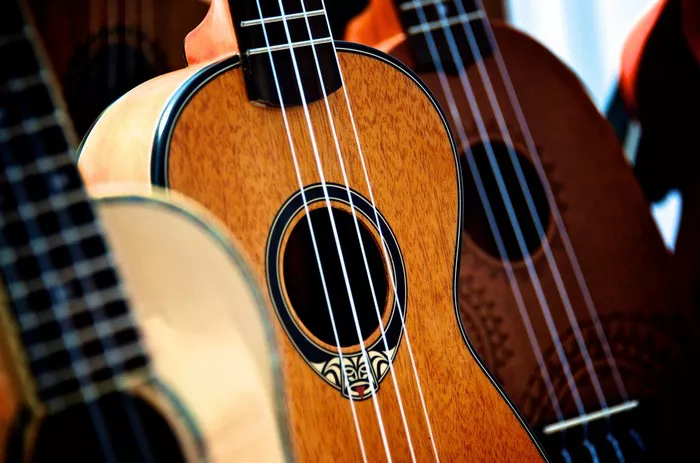Learning to play the ukulele involves familiarizing oneself with various chords, and among them, the G7 chord is a fundamental and versatile element. In this comprehensive guide, we will delve into what G7 is on the ukulele, how to play it, and its significance in the world of music. Whether you’re a beginner or an experienced player, understanding the G7 chord opens up a wealth of melodic possibilities.
Demystifying G7: What is the G7 Chord?
The G7 chord is a type of seventh chord, a staple in Western music. It consists of three essential notes: G, B, and D, along with the seventh note, F. In ukulele terms, the G7 chord is formed by placing your fingers on specific frets of the ukulele’s neck to create this combination of notes.
The G7 chord is part of the larger G chord family, which includes variations like G major and G minor. What sets the G7 chord apart is the addition of the F note, providing it with a distinctive sound that adds tension and excitement to a musical composition.
Playing G7 on the Ukulele: Fingering and Technique
Playing the G7 chord on the ukulele requires placing your fingers on the appropriate frets to create the necessary notes. Here’s a step-by-step guide to fingering the G7 chord:
1. Start with the G Chord Position: Begin by positioning your fingers to play the G major chord. Place your ring finger on the third fret of the E string (the bottom string), your middle finger on the second fret of the A string, and your index finger on the first fret of the high G string.
2. Add the Pinky for the Seventh Note: To transition to the G7 chord, lift your index finger, and add your pinky to the third fret of the A string. This introduces the seventh note, F, completing the G7 chord.
3. Strum All Four Strings: Once your fingers are in the correct positions, strum all four strings of the ukulele to produce the full G7 chord sound.
Practicing this fingering and strumming technique will help you become comfortable with playing the G7 chord smoothly and accurately.
G7 in Chord Progressions: Its Musical Role
Understanding the G7 chord is not just about playing a single chord but recognizing its role in chord progressions. The G7 chord often serves as a dominant seventh chord, creating tension and a sense of anticipation that naturally resolves to the tonic chord, typically the C chord in the key of C major.
In chord progressions, the G7 chord frequently precedes the C chord, creating a perfect cadence. This movement from G7 to C is a classic and satisfying resolution found in countless songs across various genres. The tension introduced by the F note in the G7 chord seeks resolution, making the transition to the C chord a harmonically pleasing resolution.
Common G7 Variations: Expanding Your Repertoire
While the standard G7 chord is a fundamental component of ukulele playing, there are variations and embellishments that add depth and flavor to your musical repertoire. Here are two common G7 variations:
1. G7sus4: This variation introduces the suspended fourth note, C, into the G7 chord. To play G7sus4, lift your ring finger from the G7 chord position, allowing the A string (second string) to ring open. This variation provides a suspended, dreamy quality to the chord.
2. G7 Barre Chord: For a different voicing of G7, you can play a barre chord. Bar the entire second fret with your index finger and place your middle finger on the third fret of the A string. This shape allows you to move the G7 chord up and down the neck, providing versatility in different musical contexts.
Experimenting with these variations allows you to add nuance and creativity to your playing, making your interpretation of the G7 chord unique.
Tips for Mastery: Practice and Progression
Mastery of the G7 chord, like any other chord, comes with practice and consistency. Here are some tips to enhance your proficiency:
1. Isolation Practice: Focus on transitioning smoothly between the G and G7 chords. Isolate this movement and practice until the transition feels natural and seamless.
2. Metronome Practice: Use a metronome to practice strumming the G7 chord in different rhythms and tempos. This helps improve your sense of timing and rhythm.
3. Incorporate G7 in Songs: Look for songs that prominently feature the G7 chord. Practice playing these songs to familiarize yourself with the chord’s application in real musical contexts.
4. Experiment with Strumming Patterns: Explore various strumming patterns to bring dynamic expression to the G7 chord. Experiment with downstrokes, upstrokes, and different rhythmic patterns to discover the versatility of this chord.
See Also: The Ukulele: What Sets it Apart from Other Instruments?
Conclusion: G7 as a Gateway to Musical Expression
In conclusion, the G7 chord on the ukulele is more than just a sequence of frets; it’s a gateway to musical expression and creativity. Understanding its formation, practicing various fingerings, and recognizing its role in chord progressions empowers you to infuse your playing with the tension and resolution that the G7 chord inherently carries.
As you embark on your ukulele journey, embrace the versatility of the G7 chord and explore its nuances. Whether you’re strumming along to classic tunes or incorporating it into your original compositions, the G7 chord opens up a world of melodic possibilities on the ukulele.


